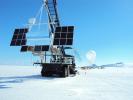Climate Change
Trip to the top of the world
January 9, 2024
Share

Return hike from servicing a climate data telemetry station on White Glacier Hill, May 2023. From left to right, Madeline Myers (ICELab PhD Candidate), Dr. Alison Criscitiello (University of Alberta), Sofia Guest (ICELab MSc student), and Miles Ecclestone (Trent University).
Some people live close to work. Others need to take a car ride, two planes (one of which lands on skis on a frozen lake), and a snowmobile or skis to their destination – that’s what fieldtrip season looks like for Laura Thomson (Geography and Planning) and her students at Queen’s Ice, Climate, & Environment Laboratory (ICELab). Each Spring, they hop on a flight to Resolute Bay, Nunavut, and then another one to Axel Heiberg Island, where they work for three to four weeks managing one of Canada’s oldest glacier monitoring programs.
The original buildings of the historic McGill Arctic Research Station, built in 1960, still shelter the researchers that venture on this chilly trip. The remote location is exactly what they need to investigate the processes that drive glacier change and how it contributes to issues like the global sea-level rise observed in face of climate change.
Once on the top of the White Glacier in the high Arctic, Dr. Thomson’s team studies the many layers of snow that accumulate over time to sustain the region’s glaciers. On the lower parts of the glacier, with poles drilled five metres deep in the ice, they measure how snow and ice is melting year after year, as regional temperatures rise at rates more than two-times the global average. They also rely on more sophisticated instruments to assess the energy balance on the glacier, that is, the essential climate variables that contribute to snow and ice melt (incoming and outgoing radiation, temperature, wind speed, etc.).

ICELab PhD Candidate Wilson Cheung drilling on Turner Glacier, Auyuittuq National Park, Baffin Island, April 2022.
"Monitoring glaciers allows us to measure the difference between the amount of melt we have in the summer and the amount of snowfall we have in the winter," explains Dr. Thomson, who is also the Canada Research Chair in Integrated Glacier Monitoring Practices. "If you measure that for decades, you get a long-term sense of how these glaciers are changing, which indicates how the climate in that region is changing."
The physics of ice
Field-based measurements are one of the main components of Dr. Thomson’s glaciology research program, combined with remote sensing (that allows research to cover expansive regions) and computer models (which help the team to play with variables and see what would happen to the ice in different scenarios). Together, these three approaches allow for a broad understanding of glacier change through space and time.
"Glaciology is a slow game. In climate science, we try not to draw conclusions on results in less than 30 years."
– Dr. Laura Thomson
Joining Queen's in 2018, Dr. Thomson's research is building on a 60-year data record and is already providing interesting insights.

In the first decades of data collection in the 1960s and 1970s, results indicated a relative stability in the White Glacier, meaning accumulated snowfall balanced melt. In the 1990s and 2000s, however, there was an observed augmentation of melt, leading to glacier’s shrinking. Surprisingly, little change was recorded in winter snowfall patterns.
"We would expect warmer and wetter winters, but, for some reason, in this area, our data suggests it has been snowing just as much as it had in the past," says Dr. Thomson. What is driving glacier changes, then? Dr. Thomson’s team have found that increasing summer temperatures and subsequent high-levels of melt is the cause – which aligns with results from other researchers working across the circumpolar arctic. Summer snowfall at high elevations remains an unmeasured variable that could help to offset these losses, and Dr. Thomson and students have now put new instruments in place to measure snowfall throughout seasons and verify that hypothesis.
Towards a sustainable research model for the Arctic
The ICELab team is currently working to expand its research beyond the monitoring of the White Glacier. It is working, for example, to further understanding of how glacier melt impacts, and is impacted by, the oceans and sea ice conditions.

The 2023 ICELab field team heads back to camp on Axel Heiberg Island, NU. From left to right, Sofia Guest (MSc student), Madeline Myers (PhD student), and Miles Ecclestone (Trent University).
A partnership with Parks Canada has allowed for the creation of two new monitoring programs on Bylot Island and Baffin Island, both in Nunavut. These locations, located further South than Axel Heiberg Island, have more challenging weather and terrain and are harder to access. Their glaciers, however, are changing more rapidly and can provide valuable data to study climate change.
The researchers are working with guidance from Parks officers who are local to the region. The community members guide researchers to the field through the trails that have been used for generations. "It’s been amazing, and we couldn’t do this work without them," says Dr. Thomson.
Moving forward, ICELab is also looking at ways to limit the carbon footprint and overall environmental impact of their research, such as using skis and snow kites whenever the conditions allow during the fieldtrip to reduce the use of fueled snowmobiles. They are also choosing alternative materials to cut down on the use of one-time-use plastics and Styrofoam in packing equipment and instrument installation and maintenance.

Dr. Thomson conducting snow pit analysis on Turner Glacier, Auyuittuq National Park, Baffin Island, April 2022.
To create a blueprint for future research, ICELab is actually looking at the past, when some of these alternative materials and methods were used. The team is hoping to tell the story of Arctic research through a compilation of photos and audio records taken by researchers throughout the decades, as well as interviews with scientists that have worked in the area.
"We commonly use satellite images and maps to tell the story of how the Arctic is changing, but that’s not how we naturally see the world. The human perspective is just as important," says Dr. Thomson.
Distance isn’t the only challenge to doing fieldwork in the Arctic. Although the team has enough sunlight hours to work on the glacier in April and May, temperatures range from -25 to -15 Celsius degrees, which is not exactly mild for outdoor activities. Unexpected warm weather, on the other hand, can also cause trouble as the snowmobiles are difficult to operate in soft snow or on bare ice. Additionally, because the glacier is a dynamic environment that naturally changes due to ice flow, each year the group needs to find a safe route to travel some 15 kilometres on the ice, making sure to avoid the deep open cracks called crevasses. None of that, however, scares Dr. Thomson out of the field. “I have a toddler at home and that's harder than Arctic work,” she says.

![[SNO+ detector at SNOLAB]](/gazette/sites/gazettewww/files/styles/xsjpg1x3to2/public/2024-04/McDonald-Institute-funding-1800x1200-Gazette.jpg?itok=6Lwe0LRj)

